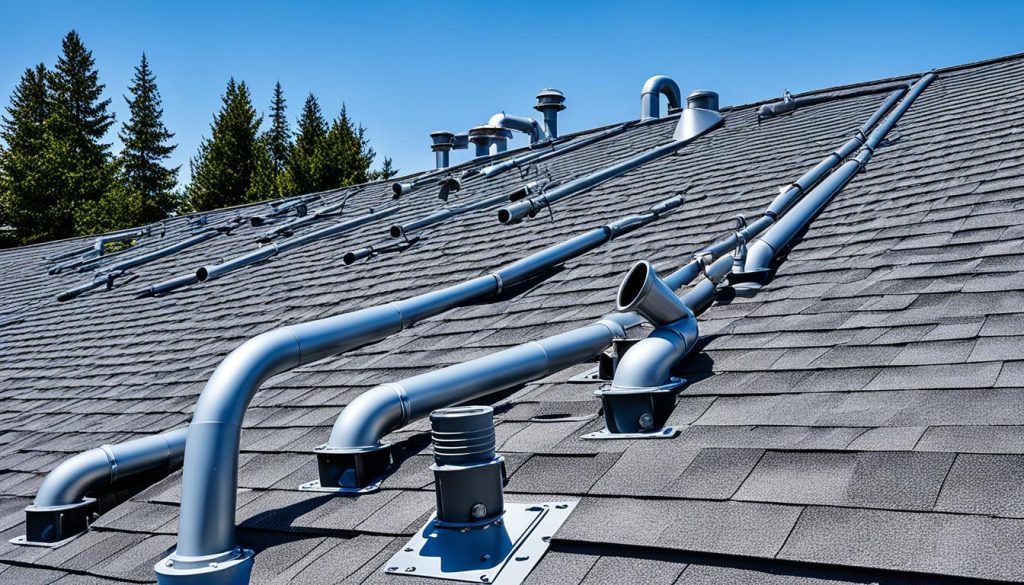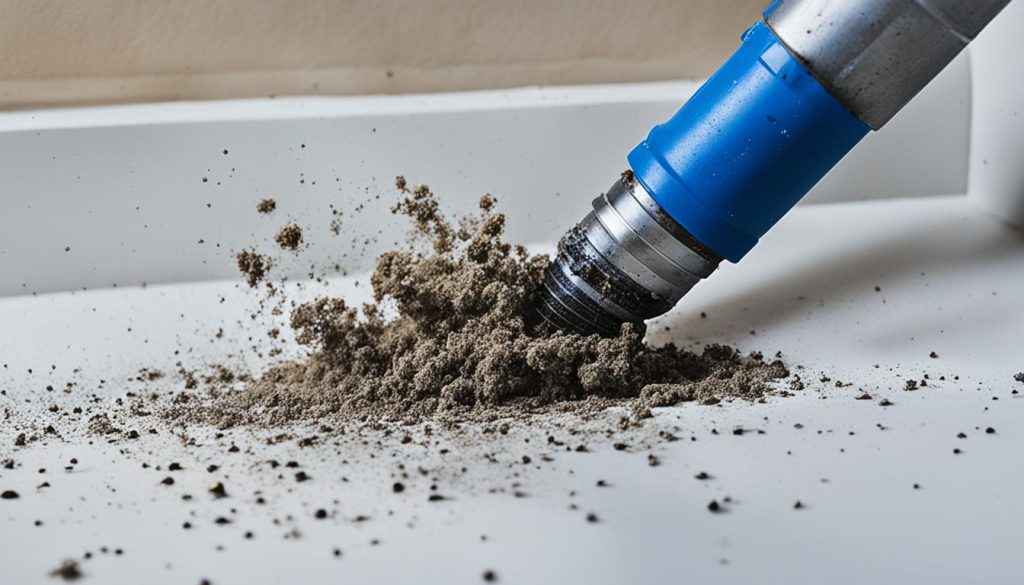Identifying Plumbing Vents: What Do They Look Like?
Did you know that plumbing vents are essential for maintaining a healthy and functional plumbing system in your home? These often overlooked vertical pipes play a crucial role in ensuring proper drainage and preventing sewer gases from entering your living space.
Plumbing vents are not only functional but also have a distinct appearance. So, what do they actually look like?
Plumbing vents typically protrude from the roof and can be easily identified by their upright position. They are designed to release gas and odors from the plumbing system and allow fresh air to enter, maintaining optimal pressure and preventing blockages.
If you’ve ever wondered what these vents look like or want to learn more about their importance, you’ve come to the right place. In this article, I’ll delve into the characteristics of plumbing vents, how they work, common types, signs of vent issues, and how to unclog them. So, let’s dive in!
Key Takeaways:
- Plumbing vents play a crucial role in maintaining proper drainage and preventing sewer gases from entering your home.
- They are easily identifiable by their upright position protruding from the roof.
- Understanding plumbing vent characteristics is important for recognizing and addressing vent issues.
- Clogged vent pipes can cause issues such as ghost flushing and slow draining sinks.
- Unclogging a plumbing vent can be a DIY task or require professional assistance depending on the severity of the blockage.
How Plumbing Vents Work
Plumbing vents are an integral part of the plumbing system, working together with drainage pipes to ensure proper airflow and water flow. These vents play a crucial role in maintaining the functionality of plumbing fixtures by supplying fresh air.
Plumbing vent characteristics are designed to allow efficient waste removal from the home. They prevent sewer gases and odors from backing up by providing an escape route through the vent system. This ensures a healthy and odor-free environment inside the house.
The plumbing vent design consists of vertical pipes that extend above the roofline. These pipes are usually made of durable materials such as PVC or cast iron. By protruding from the roof, plumbing vents create a path for air to enter the system and balance the air pressure, which prevents water from siphoning out of traps and causing gurgling sounds or slow draining sinks.
The plumbing vent structure is essential for preventing clogs and maintaining the proper functioning of the drainage system. It allows for the release of wastewater gases, preventing potential health hazards and protecting the integrity of the plumbing system.
When combined with drainage pipes, plumbing vents create a balanced and efficient system that ensures smooth water flow and effective waste removal.
Types of Plumbing Vents
When it comes to plumbing vent pipes, there are several types available to cater to the specific needs of your plumbing system. Each type serves a different purpose, ensuring the proper functioning of your plumbing system. Let’s explore the various types of plumbing vents:
True Vent
The most common type of plumbing vent is the true vent. It is a vertical pipe that is connected to the drain line and extends through the roof. The true vent allows air to enter the plumbing system, maintaining proper air pressure and preventing sewer gases from entering your home.
Revent Pipes or Auxiliary Vents
Revent pipes, also known as auxiliary vents, are attached to the drain line near specific plumbing fixtures. They serve as additional vents that connect to the main vent, ensuring efficient airflow in the plumbing system.
Common Vents
Common vents are used when two plumbing fixtures on opposite sides of a wall need to be connected to the vent stack. They provide a shared venting option, ensuring proper ventilation for both fixtures.
Wet Vents
Wet vents are unique as they serve a dual purpose. They function as both drain pipes and vents, allowing water to drain from one fixture while venting air from another. This type of vent is commonly used in certain plumbing configurations to optimize space and efficiency.
Loop Vents
Loop vents are a type of venting option that allows for venting without connecting to a larger venting system. They are often used in situations where a traditional vent stack is not feasible.
Air Admittance Valves (AAVs)
Air admittance valves (AAVs) provide an alternative venting solution that eliminates the need for a larger venting system. These valves open to allow air into the plumbing system when needed and close to prevent the escape of sewer gases.
Each type of plumbing vent pipe has its own unique characteristics and applications. By understanding the different types available, you can ensure that your plumbing system is properly vented and functioning efficiently.
Signs of Plumbing Vent Issues
Blocked vent pipes can cause various problems in your plumbing system. It’s important to be aware of the signs that indicate a potential vent pipe blockage. By identifying these signs early on, you can take the necessary steps to address the issue and prevent further damage to your plumbing system.
- Ghost Flushing: If you notice that your toilet flushes on its own without anyone using it, this could be a sign of a vent pipe blockage. The blockage can cause air pressure imbalances, leading to the toilet flushing spontaneously.
- Slow Draining Sinks: Another indication of a clogged vent pipe is slow draining sinks. If multiple sinks in your home take longer than usual to drain, it could be due to restricted airflow caused by the blockage.
- Gurgling Sounds: Unusual gurgling sounds coming from your drains or toilets can be a sign of vent pipe problems. The blockage disrupts the normal flow of air and water, leading to these strange noises.
- Sewage Smells: Foul odors emanating from your drains or near your plumbing fixtures can indicate a clogged vent pipe. The blockage prevents sewer gases from escaping, causing the unpleasant smells to linger in your home.
It’s crucial to address vent pipe blockages promptly to prevent further issues with your plumbing system. If left untreated, a blocked vent pipe can lead to poor water flow, backups, and potential damage to your pipes.
To visually understand the signs of plumbing vent issues, refer to the image below:
Next, we’ll discuss how to unclog a plumbing vent and restore proper functionality to your system.
How to Unclog a Plumbing Vent
If you suspect a clogged plumbing vent, there are two options for unclogging it. The first option is to attempt unclogging it yourself by following these DIY steps:
- Start by clearing any debris from around the vent pipe.
- Inspect the pipe for any visible blockages or obstructions.
- If you can see a blockage, try using a plumber’s snake or a long, flexible wire to break it up and remove it.
- If the blockage is stubborn, you can try using a garden hose with high-pressure water to dislodge it. Direct the water into the vent pipe and ensure it flows freely.
- Once you’ve cleared the blockage, run water through the plumbing fixtures connected to the vent pipe to check for proper drainage.
However, keep in mind that working on a vent pipe can be challenging and may require specialized tools. If you’re unsure or uncomfortable performing the unclogging process yourself, it’s always best to hire a professional plumber.
A professional plumber has the expertise and necessary tools to quickly and effectively unclog the vent pipe. They have access to specialized equipment like drain augers and hydro-jetting machines, which can thoroughly clear the blockage and restore proper airflow in your plumbing system.
By opting for professional vent pipe unclogging, you can have peace of mind knowing that the issue will be resolved efficiently, minimizing the risk of further damage to your plumbing system.
| DIY Vent Pipe Unclogging | Professional Vent Pipe Unclogging |
|---|---|
| Requires manual labor and basic tools | Utilizes specialized equipment and professional expertise |
| May take longer to completely clear the blockage | Offers quick and efficient resolution |
| Suitable for minor blockages or DIY enthusiasts | Ideal for complex or stubborn clogs |
| May not address underlying issues | Identifies and resolves underlying plumbing problems |
| Lower cost | Higher cost |
Importance of Regular Maintenance
Regular maintenance is essential to keep your plumbing vents in optimal condition and prevent vent pipe blockage. By taking proactive measures to maintain your plumbing vents, you can ensure the proper functioning of your plumbing system and avoid costly repairs.
One important aspect of vent pipe maintenance is clearing debris from around the vent pipe. Leaves, twigs, and other debris can accumulate around the pipe, potentially blocking the airflow and causing issues. Regularly inspecting and clearing any debris can help prevent blockages and maintain a smooth flow of air.
In addition to debris clearance, it is crucial to inspect your vent pipes for any signs of blockage. Slow draining sinks, gurgling sounds, and sewage smells are indications that there may be a blockage in your vent pipe. If you notice any of these signs, it is recommended to schedule professional vent pipe cleaning to ensure the blockage is effectively removed.
By prioritizing plumbing vent maintenance, you can prevent vent pipe blockage and ensure the longevity of your plumbing system. Regular maintenance not only helps in maintaining proper airflow and preventing sewer gases from entering your home but also saves you from the hassle and expenses of dealing with clogged pipes in the future.
Source Links
- https://www.rsandrews.com/blog/check-vent-pipe-clogged/
- https://www.homeserve.com/en-us/blog/home-improvement/plumbing-vents/
- https://www.bhg.com/home-improvement/plumbing/drain-venting/
- Investing Wisely: How Windows & Doors in Boost Property Value and Financial Health - April 24, 2025
- The Financial Impact of Personal Injuries: Why Legal Help Matters for Business Owners - April 16, 2025
- The Hidden Financial Costs of Domestic Assault: What Business Owners Need to Know - April 16, 2025













